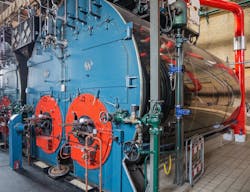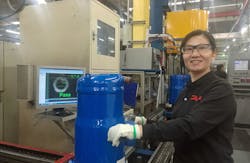Using Excess Heat to Power Industry
Every time an engine or machine runs, it generates heat. Anyone who has felt the warmth behind their refrigerator recognizes that. The same is true on a larger scale in data centers, factories and wastewater facilities.
Excess heat can be reused to supply a factory with heat and warm water or exported to neighboring homes and industries through a district energy system that supplies heat to consumers via a network of underground pipes carrying hot water. Such heat networks can cover a large area or even an entire city or supply a small cluster of local buildings. While the U.S. would need to invest in infrastructure and district heating systems, there is low-hanging fruit in facilities to apply this approach now.
According to Astrid Mozes, president, regions, at Danfoss, “The United States is sitting on a gold mine of excess heat. Excess heat is the world’s largest untapped source of energy. Despite this incredible opportunity, there are very few initiatives pushing for more efficient use of the vast amounts of wasted energy in the form of excess heat.”
Danfoss’s direct experience
As a global supplier of power, heating/cooling, drives, sensors and pump technologies, Danfoss is well positioned to comment on the potential to capture waste heat for re-use. For example, at the company’s Hayan and Wuqing factories in China, Danfoss has reduced energy consumption and emissions via three drivers: improving energy efficiency, reusing energy that has already been produced, and sourcing green energy.
At the Danfoss Haiyan Factory, smart monitoring technologies are used improve energy efficiency. Heating and cooling technology turns waste heat from the factory production processes back into the plant, delivering energy savings to the air conditioning systems.
According to Danfoss, the improved heating and cooling infrastructures across these two factories have led to a 24% increase of heating energy productivity in three years. In addition, heat recovery projects have contributed approximately 15% of these results, saving more than €300,000 in energy bills in the last year.
In its recently released white paper—‘The world’s largest untapped energy source: Excess heat”—Danfoss states that the industrial sector accounts for 39% of all global energy-related carbon emissions and is, with its current rate of energy efficiency improvements of 1% annually—not on track to meet the milestones of the net zero scenario that would require improvements of 3%. The structural challenge for factories all over the world is to meet growing demands for production while curbing emissions.
The good news is that excess heat is a huge, unharnessed potential for the industrial sector.
In the European Union (EU), industrial sites constitute the largest source of excess heat. The excess heat from heavy industrial sites in the EU amounts to more than 267 TWh (Terawatt hours) a year. To put that into perspective, this is more than the combined heat generation of Germany, Poland and Sweden in 2021. If we look only at waste heat sources over 95° C and within 10 km of existing district heating infrastructure, there is a potential of 64 TWh. This corresponds to 12% of the energy supplied to EU district heat infrastructure annually.
The potential is also striking when looking at specific urban areas. For example, in Essen, Germany, there are approximately 50 industrial sites in the urban areas around the city that produce 11.98 TWh of excess heat per year. This is roughly the amount of heat required to heat 1,200,000 households, or close to half of the households in the area.


